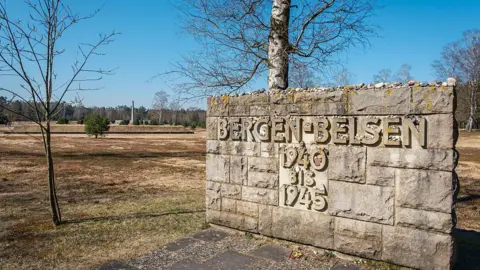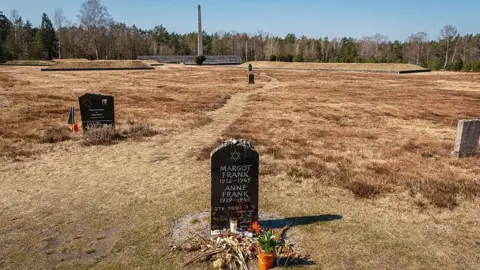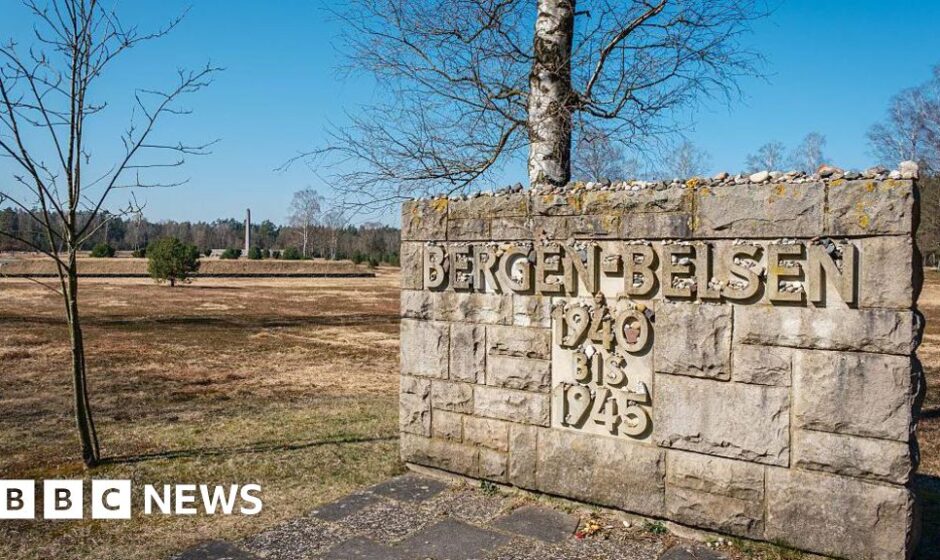BBC News at Bergen Belsen
 AFP
AFPThere had been rumours. There had been aerial photographs. There had been the written testimony of a few escapees. But it took liberation for the revelation of the shocking reality of the Nazis’ concentration camps.
Nowhere was this more true than when British and Canadian troops advanced on the camp at Bergen-Belsen, near Hanover, in April 1945.
A truce with local German commanders enabled them to enter without a fight. They were met with a stomach-churning vista of death, a torrid panorama of human suffering.
The troops calculated there were 13,000 unburied corpses. A further 60,000 emaciated, diseased, spectral-like survivors stood and lay amongst them.
To mark the 80th anniversary of the liberation of Belsen, more than a thousand survivors and families attended commemoration events at the camp on Sunday.
Row after row, they listened to people recount the horrors of the camp.
They included Mala Tribich from London, 14 then, 94 now. Belsen was, she says, “a place of skeletons, where the dead were piled up and the living shuffled around… There was death everywhere”.
Mala said she saw guards pulling the corpses along on blankets or by their limbs.
Another survivor, Esther Alice, who was aged 11 at the time, recalled the “horrible” memory of her mother dying in her arms in hut 221.
The sun shone down on Sunday’s spectacle, but Belsen still has the capacity to chill.
“To me, Belsen was the ultimate blasphemy,” wrote one British soldier, Michael Bentine, who, after World War Two, went on to become a famous entertainer.
Other chroniclers, film-makers and diarists struggled to convey in words and pictures the scenes that made unwanted incursions into their minds.
The BBC’s Richard Dimbleby was the first broadcaster to enter the camp shortly after liberation. In his landmark broadcast he included the words: “This day at Belsen was the most horrible of my life.”
Belsen’s notoriety soon stood out, not just because of the chillingly vivid accounts of journalists, soldiers and photographers, whose testimonies were sent around the world, but because it was found with all its grotesqueness intact.
Other camps further east, like the death camps of Treblinka, Sobibor and Auschwitz, had either been destroyed by the Germans to hide their crimes in the face of Soviet advances or emptied of their inmates.
At Belsen, the huts, the barracks, the evidence, remained.
At Belsen, there were witnesses, perpetrators, victims.
It was where many of those eastern concentration camp prisoners ended up. Overcrowding led to dysentery, malnutrition and typhus.
There were no gas chambers at Belsen. It was Nazi cruelty and incompetence that accounted for the 500 deaths a day that the camp endured.
And most of it came in the final weeks of the war, well into April 1945.
 FOCKE STRANGMANN/AFP
FOCKE STRANGMANN/AFPAs the Third Reich collapsed and freedom came to those in other occupied territories, the dying continued at Belsen: between 50,000 and 70,000 people in total, more than 30,000 of those between January and April 1945.
Around 14,000 of the prisoners died after liberation, their digestive systems unable to cope with the highly calorific, rich sustenance offered by well-meaning cooks and medics.
The vast majority were Jews, with Soviet prisoners of war, Sinti and homosexuals among other groups to be engulfed by the horrors of the camp.
Sunday’s anniversary was a commemoration to those who never left here, forever to be a part of a crime that continues to arc its way across history.
Among the survivors and relatives who attended the event were 180 British Jews. Their journey was organised by Ajex, the Jewish Military Association.
Wreaths were laid by Ajex veterans, as well as dignitaries, including Deputy Prime Minister Angela Rayner.
A psalm was read by UK Chief Rabbi Sir Ephraim Mirvis.
They did so amid the verdant surroundings of Lower Saxony, where the watch towers, fences and buildings have gone.
That’s because, in the end, to contain disease, the British soldiers decided they had to burn the huts at Belsen.
And so, today, little remains. A visitor centre is a focal point, near to where a handful of memorial stones and crosses have been erected.
The inscription on one reads: Hier ruhen 5,000 toten – here rest 5,000 dead.
It is just one of the graves, one of the memories, that haunt the grassed landscape.
#years #survivors #families #remember #camps #horrors



